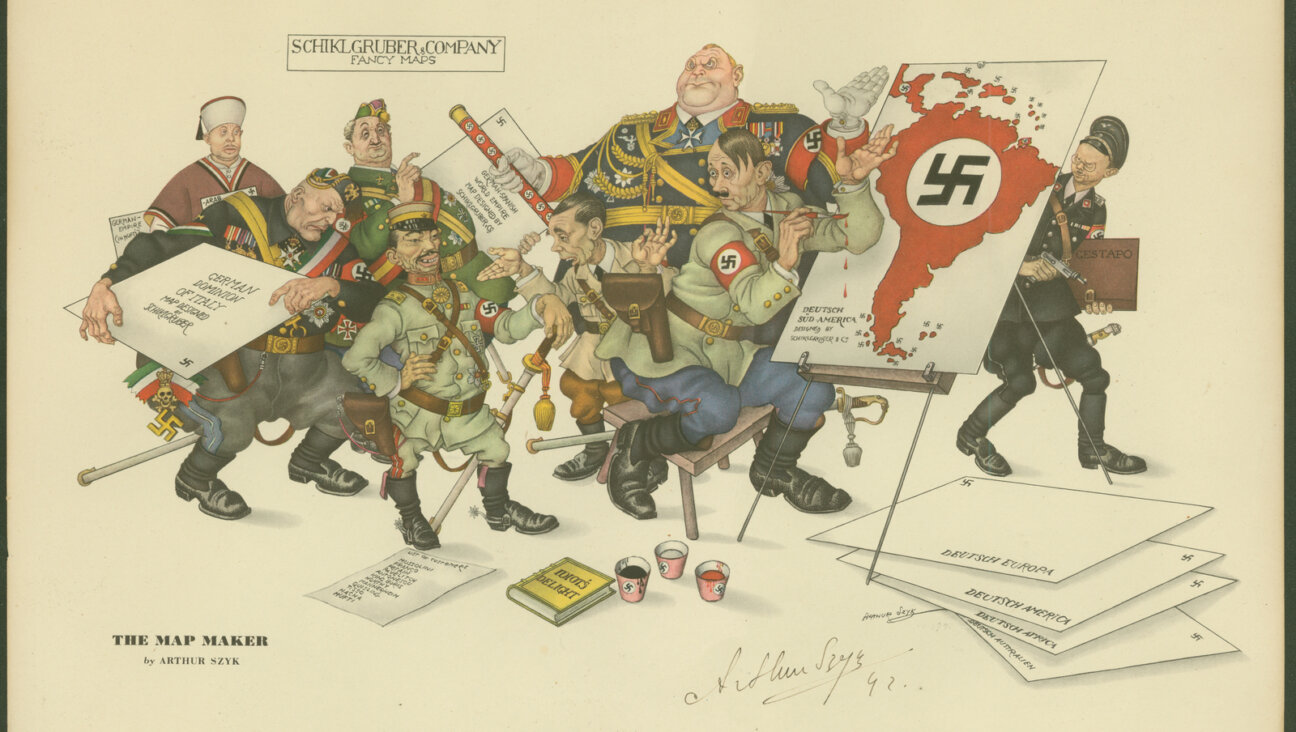Is ‘Nuremberg’ the Holocaust movie we need right now?
A new film focuses on the relationship between Hermann Goering and his psychiatrist, Douglass Kelley

Rami Malek as Douglass Kelley and Russell Crowe as Hermann Goering. Courtesy of Sony Pictures Classics
Holocaust movies have become such a genre of their own that it is hard for them to find anything new to say. Yet directors keep trying — perhaps out of a sense of duty, or the assumed prestige of the subject matter — to keep the atrocities front of mind.
Nuremberg, a star-studded new film written and directed by James Vanderbilt (the writer of Zodiac and both installations of the Adam Sandler-Jennifer Anniston hit Murder Mystery), focuses on the trial of Hermann Goering, Hitler’s second-in-command. The drama distinguishes itself from previous treatments of the trial by centering Douglass Kelley, the psychiatrist charged with assessing Nazis’ readiness to take the stand. Based on the book The Nazi and the Psychiatrist by Jack El-Hai, the film stars Russell Crowe as Goering and Rami Malek as Kelley.
But Nuremberg’s two-and-a-half-hour runtime attempts to take on more than Kelley’s observations about the nature of evil; the entire second half is a courtroom drama, which follows the beats of the unfolding trial. The movie fits in the backstories of some of Goering’s co-defendants, the establishment of a new model of international law and a romantic subplot touching on the media circus surrounding it all. A late reveal in this overcrowded movie shows Kelley’s translator to be a German Jew, and we hear the story of his escape from the Nazi regime.
It’s a big project, with the cast to match, and it’s full of factoids designed to make its message about the horrors of the Nazis unmistakable. But Nuremberg is an entry into a field crowded with Holocaust content. Is this the new Holocaust movie we needed?
Why now for a Nuremberg movie?
On the 80th anniversary of the end of World War II, and the start of the Nuremberg trials, the Nazis and their crimes remain topical. In October, a leaked group chat of the Young Republicans showed members openly joking about gassing Jews and proclaiming their “love” for Hitler; many of the members of the chat worked in state governments. (Vice President JD Vance defended them as “kids” making “edgy, offensive jokes.”) Tucker Carlson just interviewed avowed antisemite Nick Fuentes, legitimizing a man whose extremist rhetoric once relegated him to the fringe, and moving him into the mainstream. The current administration is engaged in a campaign of deportations, at least some of which have caught citizens in their dragnet.
The movie was in production long before any of these stories broke. But the rise of antisemitism, neo-Nazism and fascism in the U.S. — and Europe — has been apparent for at least a decade, fueled by social media and online forums where conspiracy theories and a resurgent white nationalism and nativism fester, sometimes breaking the internet’s containment to appear on political daises and in white supremacist marches.

“I think it’s important to not forget the past,” James Vanderbilt offered in an interview with The Catholic Review, adding that, “we have to be able to look backwards in order to move forwards.”
In this context, Nuremberg feels more like an urgent history lesson than a work of cinema, despite its aspirations to artistry; its clumsy exposition doesn’t help its schoolmarmish tone.
Why the psychiatrist?
In the film, Douglas Kelley arrives in Nuremberg hoping to discover what made the Nazis, and Germans, uniquely predisposed to, and capable of, great evils. “If we could psychologically define evil, we could make sure something like this never happens again!” he asserts. What Kelley found, in lieu of a diagnosis, was normal people. It’s the banality of evil, years before Arendt coined the phrase — and presents an opportunity for the movie to tee up a clear moral message.
Given that the Nuremberg trials lasted years and were extremely complex, narrowing the focus to Kelley and Goering’s dynamic could have helped to prevent overwhelming the audience while offering viewers a window into the minds of the Nazi leadership.
But we walk away with little insight into Goering’s own motivations. Kelley repeatedly emphasizes the Reichsmarschall’s manipulativeness and exhorts Justice Robert Jackson, the American prosecutor played here by Michael Shannon, to prey on the Nazi’s narcissism in his cross-examination. But we don’t see Goering do much manipulating beyond initially pretending not to speak any English, nor do we see much narcissism beyond remarking that he thinks he will escape the hangman’s noose.
Kelley mostly comes off as incompetent and eager for a book deal, not a masterful observer of the human condition, so we are given little reason to trust his insights.
How does this compare to other portrayals of Goering? Of the trial?
The most famous narrative film about the Nuremberg trials is Stanley Kramer’s 1961 Judgment at Nuremberg. Its characters are fictionalized and the action takes place at a later stage of the trial, years after Goering has escaped his hanging via a cyanide pill. Its focus is not on the high command, but the Nazi judicial system and everyday Germans. (It’s rooted in the 1947 Judges’ Trial, but reduces the number of defendants in the dock considerably.)
Much closer to Nuremberg is a 2000 TV miniseries, also called Nuremberg, starring Alec Baldwin as Jackson, the American prosecutor, and Brian Cox as Goering. Cox’s Goering is quite a bit more brash than Crowe’s, but, with his charm and chattiness with the guards, hits many of the same beats.

The main difference between the two Nurembergs comes in the portrayal of Goering’s motivations. In the movie, the Reichsmarschall displays no antisemitism and speaks only of his patriotic duty to Germany; he insists he had no knowledge of the Final Solution. His weakness, it seems, and his evil, is encapsulated in his devotion to Hitler.
In the miniseries, though Kelley does not feature, the psychiatrist Gustave Gilbert — who also briefly appears in Vanderbilt’s film played by Colin Hanks — serves much of the same function. In one memorable scene, Goering calls out the hypocrisy of America, with its segregation, trying Nazis for their race laws, and explains how Jews exploited Germans.
When Gilbert doesn’t see his logic, Cox’s Goering barks back: “You will never understand antisemitism. Why? Because you are a Jew.”
The moment implies, more than any scene in the movie version, that Goering could have been a true believer, rather than a career military man and opportunist.
How did the movie deploy its archival footage?
Despite the subject matter, the film mostly dodges direct discussion of the Holocaust — until it inserts archival footage of the concentration camps.
During the actual Nuremberg trials, a 52-minute film, directed by John Ford, showing the crematoria, death pits, and abysmal conditions of the camps was played for the courtroom. The film uses an excerpt of the film in the trial scene. Vanderbilt chose to show the footage to the actors for the first time on set, wanting to capture their real, unfiltered reactions.
The use of archival footage reminds viewers that this story is not some Hollywood fantasy, but the rest of the film lacks this emotional power. Even when Kelley’s German-Jewish translator, Howard Triest (Leo Woodall), reveals his heritage to Kelley, a scene meant as an affecting turning point for the protagonist, its execution gives it the feel of something out of an afterschool special. The documentary footage gives the movie weight, but feels out of place in a film that otherwise has the sheen, waxy makeup and shallow characterizations of a Hollywood blockbuster.
What was the movie trying to do?
Nuremberg tries, often didactically, to spread the warning Kelley himself hoped to convey in his book, 22 Cells in Nuremberg: A Psychiatrist Examines the Nazi Criminals, that all people have capacity for heinous deeds.
Highlighting the banality of evil has become a trend in recent Holocaust dramas like The Zone of Interest. But unlike that film, Nuremberg relies on didactic expository dialogue. (“Jesus Christ, that’s Hermann Goering!” says an American soldier in the opening scene, before his comrade asks “Who?” and he responds with a Wikipedia precis.) It is much less interested in setting up a compelling story with deep characters than it is in lecturing the audience.

And though, by the end, the movie disavows the idea that morality — or immorality — is inherited, it gives more airtime to Kelley’s pursuit of a diagnosis of evil than it does to his conclusion that such a thing does not exist. Though a brief final scene shows the psychiatrist on a radio show warning that evil is just as possible in the U.S., we don’t see him arrive at that conclusion in the movie.
Is this an effective Holocaust movie?
At their best, Holocaust movies are able to force audiences to feel the horror of the concentration camps or make the inhumanity of the Nazis palpable. The Zone of Interest‘s most impactful scenes showed Rudolph Höss’ children playing cheerfully in the garden with the smoky plumes of Auschwitz’s crematoria in the background.
Vanderbilt tries to pack too much information into Nuremberg, leaving us with a movie that has to tell rather than show. The result is something more educational than evocative, providing a hurried overview of how the Nuremberg trials came about and a crash course on the Third Reich’s hierarchy. Its lack of focus makes it, at times, feel like a slog, and the movie depends on its star-studded cast and the inherent solemnity of its subject matter for viewers’ attention.
For those hoping to understand more about Goering’s psyche, Kelley’s own book — or The Nazi and the Psychiatrist, on which the movie was based — might be a better resource. For those hoping to delve into the entire history of the Holocaust, no one movie can capture it.

















